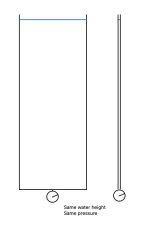Billy Jackson
New member
Area of a circle is radius squaredytimes pi, not diameter. Perimeter is diameter times pi. In most books it's written as 2 x pi x r.16.65 pounds
Larger pipe area is inside diameter squared times pi divide by 4 subtract the outside diameter squared times pi divide by 4
Divide that number by 144to convert to square feet multiple by 100 to get cubic feet multiple by 62.4 pcf for water to get answer
Done on cheap small calculator so I probably have fat finger mistake in final answer
